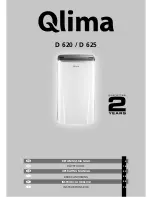
11
Product Overview
3.4
Functional description
From the reverse-osmosis system (RO system) the fully demineralized water (also called RO water or
permeate) is fed via a shut-off valve (18, by others) and a external water filter 5 µm (19, recommended,
option or by others) to the central unit (17).
In the central unit the RO water is fed via the inlet valve Y1 (11), the conductivity sensor Lf1 (14), and
the silver ionization (13) for disinfecting the water and the optional sterile filter (9) to the valve manifold
(25) with the spray valves and the drain valve Y10.
On systems type A the central unit is equipped with a booster pump (10) (controlled via the frequency
converter) which increases the water pressure to the required operating pressure of approximately
101.5-108.8 psi (7-7.5 bar) (yield load) starting from a certain humidity demand.
When a humidity demand is present the spray valves open depending on the demand:
– one or two spray valves (with 2 spray circuits: Y5-Y6),
– one, two or all three spray valves (with 3 spray circuits: Y5-Y7),
– one, two or all four spray valves (with 3 spray circuits with double stage: Y5-Y7+Y9) or
– one, two, three or all four spray valves (with 4 spray circuits: Y5-Y8) or
– one, two, three or all five spray valves (with 4 spray circuits with double stage: Y5-Y8+Y9) or
– one, two, three, four or all five spray valves (with 5 spray circuits: Y5-Y9).
– one, two, three, four or all six spray valves (with 5 spray circuits with double stage: Y5-Y9 + Y9.1).
The fully demineralized water is now fed to the respective spray nozzles (31) producing fine drops.
The air passing by the nozzles absorbs the drop thus getting humidified. Drops not absorbed by the
air is retained in the post-evaporation elements (32) thus humidifying the air passing through the post-
evaporation elements. Excess water flows down to the bottom of the post-evaporation unit and is led
via the trap (29) and open funnel to the wastewater line of the building.
Control
The system is controlled by an external controller (enthalpy controller recommended) or by the P/PI
controller built into the control unit.
On systems:
– with 2 spray circuits a 3-step control is provided,
– with 3 spray circuits (with or without double stage) a 7-step control is provided,
– with 4 spray circuits (with or without double stage) a 15-step control is provided,
– with 5 spray circuits (with or without double stage) a 31-step control is provided
On systems type A the booster pump is switched on at a demand of approx. 60-70 % (switching point
is dependent on the inlet pressure), and then the capacity is controlled continuously up to 100% via the
pump speed.
Содержание DL II
Страница 79: ......












































